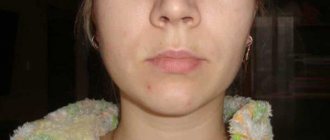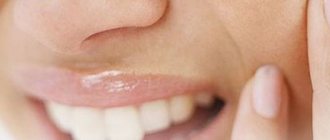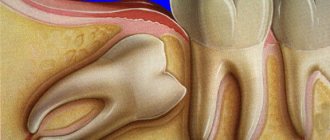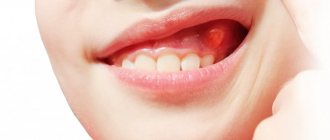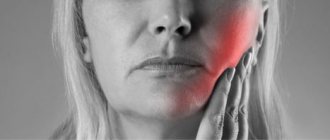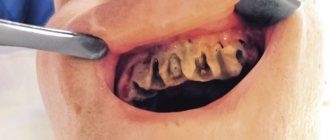Dental treatment
If the dentist does not treat the tooth correctly or completely, it can cause swelling in the cheek.
Causes:
- Allergic reaction.
It appears in the patient as a result of intolerance to the components of the filling. To eliminate swelling, you should visit a doctor and replace the installed filling with a hypoallergenic one.
- Removal of a tooth.
If the cheek is swollen after surgery, then the patient probably ignored the doctor’s recommendations and ate solid or hot foods.
- Nerve removal.
Swelling occurs if part of the nerve is not removed. It is important to see a dentist immediately so as not to lose a healthy tooth.
- Gum section.
Usually required to remove accumulated pus. If the swelling does not subside while taking anti-inflammatory drugs, this may be a serious symptom that requires the attention of a specialist.
When should you make an appointment with a doctor?
Swelling of the cheek is a symptom of an acute inflammatory process, in which you need to urgently seek medical help. Other reasons to visit a dental clinic are:
- redness and looseness of the gum tissue,
- bleeding when brushing teeth,
- constant metallic taste in the mouth,
- discomfort and pain,
- uneven height of the gingival margin,
- exposure of the necks of the teeth,
- discharge of pus from under the gums.
The temperature often rises, appetite disappears, and weakness occurs. These are symptoms of intoxication of the body.
What to do if your cheek is swollen
To reduce swelling, you can use one of the following tips:
- Rinse your mouth with a solution of salt and soda.
This remedy has an antiseptic effect and helps destroy pathogens. You can enhance the effect by adding a couple of drops of iodine to the solution.
- Use chamomile infusion to rinse
, sage or other medicinal herbs that have anti-inflammatory properties.
- Apply a cold compress to the swollen cheek
if the swelling is caused by a bite or mechanical injury. This method is contraindicated in patients who have an elevated body temperature or a tumor that develops due to inflammatory processes. Warming compresses are not recommended.
- Lotions with aloe or Kalanchoe juice.
A cotton wool soaked in the juice of the plant is applied to the inside of the affected cheek.
If the described methods do not eliminate the problem, you should seek help from a doctor. The day before, you should not take painkillers and anti-inflammatory drugs, so as not to complicate the diagnosis.
Causes of the pathological process
Inflammation of the gums and swelling of the cheek can develop due to tissue injury and the penetration of pathogenic bacteria into the wound. Inflammation can lead to:
- pericoronitis,
- complex tooth extraction or other traumatic dental surgery,
- chipping of a tooth with the formation of a sharp edge that damages the gums,
- advanced caries and pulpitis,
- tartar,
- cyst,
- poor quality filling or prosthetics.
The inflammatory process develops faster in people with reduced immunity, diabetes, and chronic diseases of the gastrointestinal tract. Also at risk are patients with complex malocclusions.
Why does my cheek swell?
Periostitis of the jaw
It is the most common dental cause of the symptom. Develops against the background of dental diseases: periodontitis, pulpitis, alveolitis, periodontitis, suppurating jaw cyst. It is provoked by open fractures of the jaws, infected facial wounds, operations, and tooth extraction. In some cases, it becomes a consequence of hematogenous or lymphogenous spread of infection from distant foci. Depending on the form, it is accompanied by the following manifestations:
- Acute serous periostitis.
Moderate swelling of the soft tissues of the cheek, redness of the mucous membrane, and enlargement of regional lymph nodes are detected. The general condition suffers slightly, sometimes there is an increase in body temperature to subfebrile levels. - Acute purulent periostitis (flux
)
.
The contours of the face are sharply changed, the predominant localization of edema is determined by the location of the inflammatory focus in the periosteum. Patients complain of sharp pain radiating to the temple, eye, ear, and neck. General hyperthermia, chills, weakness, headache, and regional lymphadenitis are observed. When examining the oral cavity, an area of swelling with a fluctuation in the center is detected - a subperiosteal abscess. - Chronic periostitis.
Slight swelling of the cheek, thickening of the jaw, and enlargement of the submandibular lymph nodes are typical. The patient complains of periodic moderate pain. The mucous membrane of the affected area is swollen, hyperemic, with a bluish tint.
Other dental diseases
Other possible dental causes of cheek swelling include the following:
- Perimaxillary abscess.
It occurs as a result of infection of the soft tissues of the perimaxillary area due to boils, tonsillitis, wounds, abrasions, and some dental diseases. Swelling is preceded by toothache, which gets worse when biting. Then dense swelling appears, the temperature rises, and appetite disappears. After spontaneous opening of the abscess, the condition improves, but subsequently the pathology may recur. - Vincent's stomatitis.
Develops when immunity decreases due to diseases, injuries, and stressful situations. The leading symptom is the formation of multiple ulcers on the mucous membrane. Swelling of the cheek is detected in severe cases of the pathology. - Noma.
An area of ulcerative-necrotic lesions of the lip or oral mucosa appears. Necrosis covers the gums, tongue, cheek tissue, and facial bones. The tissues around the area of necrosis are swollen; in severe cases, swelling from the cheek spreads to the chin and infraorbital area. - Salivary gland adenoma.
The parotid gland is most often affected. Local swelling with clear boundaries forms on the outer surface of the cheek, in the parotid zone, and spreads to the angle of the jaw, the area under the earlobe. Characterized by slow growth, painlessness at the initial stage, progression of discomfort and dry mouth as the formation increases. - Tumors of the salivary glands.
Along with adenomas, benign connective tissue neoplasia, intermediate and malignant neoplasms can form in the area of the salivary glands. The area of swelling is located in the same place as with adenomas. The swelling slowly increases in benign tumors and spreads quickly in malignant ones. - Purulent parotitis.
Swelling occurs in the parotid area, which spreads to the adjacent part of the cheek. There is severe pain, difficulty when trying to open the mouth, severe intoxication, and severe hyperthermia.
Cheek swelling
Traumatic injuries
All facial injuries are accompanied by rapidly increasing soft tissue swelling, spreading to adjacent anatomical structures. Swelling of the cheek of traumatic origin can occur with the following injuries:
- Injury.
Swelling without clear boundaries. Along with edema, pain, hyperemia, and sometimes hemorrhage are detected. The pain intensifies when opening the mouth and active facial movements. Speech and the ability to eat were preserved. - Hematoma.
Formed against the background of a bruise. A compaction appears in the area of diffuse swelling, which, as a rule, resolves on its own within 1-2 weeks. - Fracture of the upper jaw.
The most pronounced swelling is observed in Le Fort type 1 fractures, combined with neurological symptoms, hemorrhages in the conjunctiva and periorbital area. Type 2 is manifested by edema, hemorrhages in the periorbital zone, and changes in facial parameters. In type 1 fractures, swelling is more noticeable in the area of the upper lip and medial cheek. - Fracture of the lower jaw.
Injuries to the ramus, lateral and angular fractures of the bone body are characterized by swelling of the lower or outer edge of the cheek. Facial asymmetry, hematomas, bruises, articulation disorders, and stepped dentition are observed. - Fracture of the zygomatic bone.
Swelling appears in the cheekbone area, quickly spreads down the cheek, up the infraorbital region. Bruises and hemorrhages form in the conjunctiva. Along with pain, victims are sometimes bothered by nosebleeds and double vision.
Allergic reactions
Swelling of both cheeks is observed with angioedema, combined with swelling of the eyelids and lips, and breathing problems. The condition develops acutely, within a few minutes, less often – hours. It is provoked by contact with an allergen, insect bites. Along with the listed symptoms, angioedema in children may be accompanied by abdominal syndrome, and sometimes by neurological symptoms.
The cause of swelling of the cheek from the oral cavity may be an allergy to prosthetic materials. The pathological condition occurs several months or years after the installation of prostheses and is characterized by a burning sensation in the area where the prosthesis is fixed, tongue, cheeks, soft palate, changes in taste sensitivity, thirst, and dry mouth. When using metal products, a metallic taste may appear.
Ophthalmic diseases
In patients with acute dacryocystitis, swelling of the lacrimal sac area is complemented by swelling of the cheek, eyelid, and dorsum of the nose. In the chronic form of the pathology, swelling is noticeable along the upper inner edge of the cheek and covers the inner edge of the lower eyelid. Cellulitis of the lacrimal sac is characterized by sharp pain and swelling along the inner edge of the eyelid, combined with fever, weakness, weakness, headache, swelling of the cheek and paranasal area.
Neurological pathologies
Local symptoms of cavernous sinus thrombosis are exophthalmos, blurred vision, swelling and pain in the eyeball, swelling of the temple, part of the forehead, cheek, upper lip, and mastoid process. The clinical picture also includes headache, nausea, vomiting, and in case of infectious genesis of the pathology - hyperthermia, intoxication syndrome.
Swelling of the cheeks can be detected with one of the types of angioneurosis - rosacea. There is constant redness of the cheeks, nose, forehead, chin, and the formation of spider veins. The cause of swelling is persistent dilation of blood vessels, which, with a long course of pathology, leads to skin changes.
Skin lesions
Minor swelling of the cheek may result from simple contact dermatitis. The severity of the symptom increases against the background of prolonged contact with the irritant and secondary infection. With allergic dermatitis, the swelling is more noticeable and is combined with itching of the skin. Atopic dermatitis is characterized by mild swelling combined with the formation of vesicles.
Due to the abundant blood supply to the face and the structural features of the soft tissues, a boil on the cheek is accompanied by significant swelling. In the center of the swelling area there is a limited round or cone-shaped formation with a black rod in the center. After the boil has matured, yellowish pus appears around the shaft. Increasing twitching pains are noted.
In young children, swelling of the cheeks is often provoked by superficial pyoderma and occurs against the background of pustular rashes. A severe form of facial skin lesions in adults and children is erysipelas. The disease manifests itself with itching, bloating, and a burning sensation. Subsequently, the cheek swells, and a focus of clearly defined hyperemia with uneven edges, reminiscent of a geographical map, forms on it. Fever and intoxication syndrome are observed.
ENT diseases
Slight swelling of the cheeks is possible with the development of acute sinusitis or exacerbation of chronic inflammation of the maxillary sinuses. Other symptoms include pain, impaired nasal breathing, nasal discharge, weakness, fever, and signs of intoxication. Patients with large odontogenic cysts of the paranasal sinuses are bothered by a feeling of tension and heaviness. Objectively, diffuse swelling of the cheek on the affected side and protrusion of the bottom of the nasal cavity are detected.
Other reasons
Swelling of one or two cheeks is observed with the following pathologies:
- Myxedema.
The swelling is bilateral, uniform, covering the forehead and chin, making the face look puffy. In severe cases, swelling spreads to the entire body. Symptoms of hypothyroidism are observed. - Parotitis.
Due to inflammation of the salivary glands, the perimaxillary area, the outer part of the cheeks, swells. The deformation is bilateral, often uneven. The disease manifests itself acutely, accompanied by fever, chills, and signs of general intoxication. - Melkersson-Rosenthal syndrome.
The leading manifestation is periodic swelling of the lips. Possible swelling of the tongue, cheeks, eyelids. Neuritis of the facial nerve is often detected. - Phlebolith.
Stones in the veins of the cheek are often asymptomatic, but can manifest as pain and swelling, and sometimes inflammation of the affected area.
